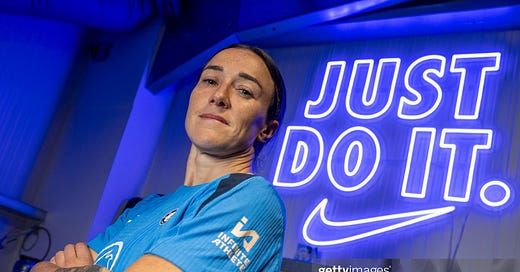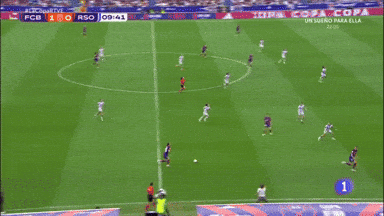The Bronze Effect: What Lucy Brings to Chelsea
Bronze signs for Chelsea and continues the squad overhaul by bringing in experience in defence.
A lot has changed at Chelsea: a new head coach, a new direction, and now, the new signing of Lucy Bronze. Chelsea have typically focused on bringing in younger talent for their recruitment, but this move is an exception.
When you look at Chelsea’s summer signings and the positions Sonia Bompastor needed to strengthen, right-back wasn’t a priority. The club already have Eve Perisset and Ashley Lawrence, who might not be perfect fits for Bompastor's style, but they bring valuable experience and versatility. This could have been a chance for Bompastor to show her adaptability and showcase a new set of tactics and in fairness, she still could as a head coach.
Still, the club went ahead and signed Bronze, a free agent after her contract with Barcelona had ended. The England international adds familiarity and leadership to a young team, thus giving the squad a strong English core.
And yet, the signing of Bronze is puzzling, if not intriguing when you take a deeper look. Why would Bompastor sanction the signing of a 32-year-old right-back when she already has two prime athletes in Perisset and Lawrence?
Some would argue that it’s a flashy, new, PR signing to appease the head coach and give Bompastor an experienced head whilst others say that this is a move that signals a different approach the former Lyon head coach wants to take.
This move supports both sides of the argument. While there are right-backs who might better fit the defensive profile Bompastor prefers, bringing in a player like Bronze, who understands her system through previously having managed Bronze, allows Bompastor to effectively communicate and implement her ideas across the squad. Alongside the facts that Bronze brings in a wealth of experience, harbours a winning culture, garners respect from the dressing room, and already knows the Women’s Super League (WSL), she still has at least another year of top-level football to bring to a team like Chelsea.
The first thing to establish is Bronze’s role in Bompastor’s 4-3-3. The system traditionally transforms into a 2-3-5 with aggressive No 8s and marauding full-backs. In theory, Bompastor would play Niamh Charles and Lucy Bronze, giving them the license to attack the spaces with inverted wingers to overlap to service Mayra Ramirez.
In reality, however, this may not be the case. Bronze’s game has evolved over the years — she’s become an aggressive ball-carrying full-back who roams into central spaces to collect possession and be on the end of passing exchanges. A younger Bronze preferred to drive down the line and cross, but the current iteration plays more of an inverted role.
During her final stretch at Olympique Lyon, Bronze was converted into an inverted full-back. Out of possession, she ostensibly played as a No. 6 to allow the central midfielders to push forward in a ball-dominant Lyon side. Spells at Manchester City and Barcelona followed a similar play pattern with slight changes to her out-of-possession position. This was to reinvigorate and evolve her game and protect the vacant space she would leave behind. It also gave her teams the security of pushing forward certain positions and creating a form of the typical 2-3-5 shape.
Taking a deeper look at Bronze’s role at Barcelona should give us a better idea of what we might expect from her under Bompastor. Bronze’s role was to play as a supportive inverted full-back. What this means is she regularly pushed high and drifted inside to contribute towards Barcelona’s midfield overload. What I expect Bronze to fulfil at Chelsea is that of a similar hybrid role where she will rotate between attacking the wide channels and providing a midfield overload when interchanging with the winger.
In Spain, she played a lot more in the attacking half-spaces and adapted to players’ movement around her, namely Caroline Graham Hansen. The two were paired on Barcelona’s right side with Graham Hansen isolated against the full-back to engage in 1 v 1s. When possession was built through the right side, Bronze’s role would mainly be supporting Graham Hansen and the right-sided central midfielder by drifting in and out of the right-back position based on their movements. If Graham Hansen shifts outside, Bronze immediately looks to drive inside, completing the passing triangle, quickening the tempo, and vice versa.
Here, Bronze starts wide, progressing forward with Graham Hansen who’s starting more on the inside. As the pass is played out to CGH, Bronze immediately inverts her run and takes up the space between the centre-back and full-back. In this case, Graham Hansen drives forward and takes the shot but the interchange between the two was key in causing chaos to Lyon’s backline.
Even here, the give-and-go between Bronze and Graham Hansen is a combination of quick, smart passing, as well as intricate movement based on the actions of each player. Bronze can adapt and be a nuisance in pockets of space when she’s in full swing with the ball.
When Bronze drives from deeper positions in the build-up, she consistently looks to advance the ball upfield before initiating passing sequences. Her contributions in moving the ball from back to front were somewhat overshadowed by the brilliance of Barcelona’s trio of midfielders. However, in most other scenarios, Bronze is more effective at getting the ball higher up the pitch. She ranked fifth in progressive passes per 90 minutes in Liga F and averaged 13.81 with 130 total progressive passes, making her the fourth-highest in the league.
Similarly, Bronze also contributes in the attacking phase through pocket crosses — the type of cross that originates from the half-spaces and is someone in an effective enough position to reach the six-yard box sooner to hit the back-post runner. With Chelsea likely to utilise Lauren James and Niamh Charles on the left, this means that back post runs, especially for Charles, become more feasible. Unlike Selma Bacha, who didn't often make these runs due to Ellie Carpenter’s box-to-box play style, Charles (as a marauding full-back) can make intelligent off-ball runs. I anticipate seeing more of these movements from her this season resulting in more goals — think Marcos Alonso at Chelsea under Antonio Conte.
This positioning is arguably ideal for Bronze in the final third as it allows her to make quick decisions and execute them immediately, as demonstrated below.
It encourages quicker play and ensures Bronze isn’t caught on the ball. I will visit this point momentarily but one of the downsides of Bronze’s attacking game is the space left behind with her recovery pace currently not what it used to be.
The defensive side of her game is unfortunately not as strong as it once was. The shift from a modern, attacking full-back to an inverted full-back was designed to cover her defensive weaknesses. As such, she remains highly effective as an aggressive, front-foot defender with solid defensive positioning when behind the ball. Bronze excels in a system that supports her forward pressing, which is a high-risk, high-reward strategy. The risk involves vacating her area and allowing the opposition winger to turn and exploit the space. However, if she successfully dispossesses the player, the reward is catching the opposition in their half and launching an immediate counter-attack.
The pressing from Barcelona here is aggressive with Lyon looking to play out directly into midfield rather than their centre-backs. Bronze tracks the pass from Wendie Renard to Danielle Van de Donk as she pushes up from her original position to stop the supply. The pressure is enough for the ball to bounce back into the path of Aitana Bonmati and Barcelona can mount an attack closer to Lyon’s goal.
When Bronze is positioned behind the ball, she usually holds good defensive positions and works well in 1 v 1 duels when she has time to react. In Liga F she ranked fifth for most defensive duels with 70 and has a success rate of 80%, which puts her third. These numbers from a purely defensive standpoint are good, but you need to contextualise this under the way Barcelona play their football. It’s possession-based versus teams who look to sit back rather than commit players forward. In the WSL, Bronze will be up against more adventurous teams so she will have to engage in more duels.
This example might not be against a team that sits deep, but the principle is similar: Bronze can see play in front of her and proactively steps in front of Lindsey Horan to tackle her and get Barcelona attacking again.
However, when she vacates her right-back position, there are times Bronze loses out in duels high up the pitch and while that can happen, the problem lies in her recovery pace to cover the space in behind.
As previously noted, Bronze can still defend her space in 1 v 1 situations. Despite this, her attacking positioning often causes issues. In a possession-based team like Barcelona, this isn’t as problematic because opposing teams tend to sit in a low block, allowing Bronze to stay forward. Looking at the example below, Bronze once again tries to step up to intercept and press Delphine Cascarino but loses out with the French winger shielding the ball, allowing it to run past into Van de Donk’s path.
Here, Bronze leaves a lot of space for Lyon to attack. Keira Walsh covers for her but Barcelona are left with three at the back, isolating Melchie Dumornay against Irene Paredes. A quicker pass or move could have resulted in a much more dangerous attack but these forward movements could be an issue for Bompastor.
The recent signing of Julia Bartel and the rumoured incoming of Oriole Jean-Francois signals an overhaul in midfield whilst the arrival of Sandy Baltimore has bolstered the attacking line. The defensive signing of Bronze means that Bompastor is willing to be chameleonic in her approach but will need to be careful in how she manages the English right-back. There are upsides to this transfer and though I can see the arguments against Bronze, there is certainly enough for her to be regarded as a useful transfer for at least a season.
Photo by Darren Walsh/Chelsea FC via Getty Images










Bronze is a very good defender and Barca defense was better when she played, however offensively she continue to hold the ball to long and dribble into traps